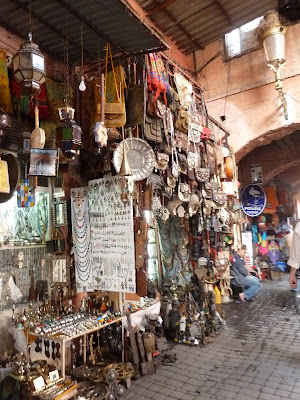The Gem and Mineral Council recently led two field trips to Morocco. The two trips ran consecutively and had (mostly) identical itineraries. The first trip was led by Tony Kampf and French mineral collector Georges Favreau while the second trip was led by our new Curator, Eloise Gaillou and Alyssa Morgan, the collection manager. Both trips had two special tour operators, Jean-Pierre (avid micromounter), and Azziz, (Berber guide from Skoura).
Why Morocco? Morocco is a small country with a diverse and fascinating geological history. There are three main mountain ranges that trend NE-SW across the northern half of the country. These are the High-Atlas and Mid-Atlas and the Anti-Atlas. The region is rich in fossils, with its thick deposits of Paleozoic ocean sediments next to older Precambrian rocks.
The Mountain belts were created (uplifted) through continental collisions, most notably during the formation of Pangaea when Africa and North America collided (325 Ma - the "Appalachian Orogeny") and in the late Mesozoic when Africa collided with Europe and Asia (the "Alpine Orogeny" also created the Alps, Pyrenees, Caucuses and other mountain ranges). These episodes of tectonic activity also lead to magma generation at depth and subsequent hydrothermal activity as groundwater is heated and rises back towards the surface, mobilizing and concentrating certain chemical components... basically creating the interesting ore deposits we will soon be visiting!
Our journey begins in Marrakech, a modern and ancient city located at the foot of the High-Atlas mountains. This is Djem El Fnaa square, the heart of the Medina, or Old City. Full of snake charmers, acrobats and musicians, it is quiet during the day and comes alive at night.
Also in the old city are the labyrinthine souks, narrow alleyways packed with tourists and locals on motorcycles.
There are locally made arts and crafts, furniture, spices and textiles for sale, but also many things that are fake! The prices are always very high and vendors can be aggressive. Our guides urged us not to buy anything in the souks!
Hidden in the alleyways of the souk are many of the city's most impressive landmarks, such as Palais Bahia, the 16th century Saadi Tombs, the Marrakech Museum, and Medersa Ben Youssef Koranic School:
Also worth visiting is the New City, modern Marrakesh. One of the nicest spots is Le Jardin Majorelle, gardens created by artist Jacques Majorelle and maintained by Yves St. Laurent:
Our first mineral collecting opportunity is at the quarry near the town of Sidi Rahhal. The quartz quarry takes place in a basaltic deposit, where the columnar structure of the basaltic flow is well observed. At the junction of the columns and inside the vesicles of the basalt, some silica-rich fluids crystallized to give rise to amazing geodes made of chalcedony and quartz (transparent to reddish due to the presence of oxides to purple –amethyst-). We had a lot of fun looking around for some nice looking geodes, and well-crystallized quartz; everybody found some interesting pieces to bring back home (already, the luggage was about to get heavier!).
The view from the quarry.
Looking in.
All the work has been done by hand! Notice the columnar structure of the basaltic flow.
Some recent finds for sale.
Geology professor Dr. Bruce Carter gave group 2 many brief lessons about the geology of the areas we were in. It was very helpful to put all these rocks and minerals into broader perspective and get a better sense of the history of Morocco!
A quick stop in town to visit some mineral dealers and have "whiskey" (mint tea with lots of sugar).

Back to Jean-Pierre's hotel, Villas Chems Hamra for dinner, and it was Bruce and Kathy's anniversary, awe, happy anniversary!
















This comment has been removed by a blog administrator.
ReplyDelete